
Ten Days of Adventure, Part II
West Yellowstone Journal
Sat, Nov 22, 2003 - By Greg Worrel
Greg wrote Part I last year - he just never got around to finishing off Part II! But he dusted off what he had, saw that it was still worth reading, and sent it on to get published. Greg's heading back to West Yellowstone this week. After reading this, you'll wish you were going, too... - Mike Muha
The Clinic
The West Yellowstone clinics provide an opportunity to refine your technique, whatever your starting level. Both five day and three day clinics are offered. The clinics include two sessions per day of an hour and a half each. At least they are supposed to be an hour and a half. One of the coaches told us they were told to keep the sessions to an hour and a half because in the past too many people were getting burned out after three or four days. In reality, you're often out skiing for four or more hours per day. It adds up.
I have not pre-registered for the clinic. It is partially out of procrastination but also because I have done the clinic twice before and I am uncertain if I want to do it again. Monday afternoon I see Dick Hunt out on the trails and ask him if I can still register.
"Oh sure," he says, "just bring your money."
I was worried that they might be full. Too many underemployed ski instructors for that. When I mentioned to Dick Fultz that I was considering doing the 5 day clinic, he looked at me with a serious expression and said "You won't get in as much skiing time."
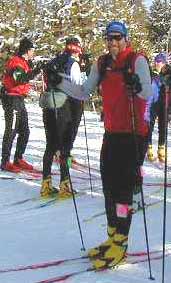 |
|
Greg at West Yellowstone |
"You might be right," he said, laughing.
One of my concerns was that the clinic might be too demanding. If I am scheduled to be out skiing twice a day, that is what I will probably do, even when I might be better off taking a break. I am more likely to take a rest if I don't have a regular schedule.
Many people come to West Yellowstone only to ski. Curt Peterson and Lorraine Lund, just back from Audun Endestad's camp in Alaska, are here just to ski. Dick Fultz, and the rest of the Michigan contingent, are skipping the clinics. Dick told me that he has stopped trying to get better. He said he just wants to ski for fun. Imagine that.
The Holiday Inn has a skier's special that includes all you can eat meal buffets. So mealtime becomes a time to meet and greet the same skiers you see out on the trail and in the classes. Since many skiers make West Yellowstone an annual pilgrimage, it can be like a homecoming for old friends.
In the hotel I see some old friends from previous camps. Jess and Judy Polokoff from Sacramento, Laura Stern and Mark Clifford from the bay area. Seeing them brings back memories of the fun we had in previous classes.
I decide to register for the clinic. While my technique is not bad, there is room for improvement. A standard part at the beginning of each clinic I've attended is splitting people up by ability. I said to someone at an earlier training camp that I will have to keep doing the clinics until they put me in the top group. They said "No, you have to keep doing the clinics until they ask you to teach." So I am still doing the clinics.
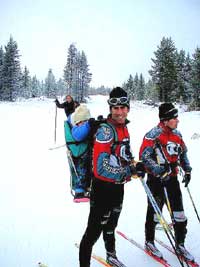 |
|
The family the skis together... |
Tuesday
It is very cold this morning. It is also the first day of the 5 day ski clinic. Start time is 8:30. No one is eager to get started in the 2-degree weather. The coaches decide to kill some time. Torbjorn leads the class in some indoor ski simulation exercises. We swing our imaginary poles and step through the motions of various techniques on imaginary snow. After about 45 minutes, everyone is tired of skiing on linoleum and we go outside.
One of the great things about the weather in West Yellowstone is that while it may be very cold in the morning, it usually warms up 20 degrees or more within a couple of hours.
The first order of business is to divide us up into groups of similar ability. The method used to do this is to have everyone ski one at a time about 100 yards doing his or her best V2 technique. At the end of the 100 yards are a couple of the coaches who call out a number as we ski by. I used to get nervous doing these evaluations. Once, in one of Torbjorn's camps, we were being individually video taped and when it was my turn, I took about three strides and stuck my pole between my skis and fell, breaking the pole. But today I don't even think about it. I get put into group number one, and I wouldn't be surprised if someone made a mental note to add me to the list of potential future instructors.
It is not an exact science, but they do a fairly good job of splitting us up. Later though, everyone is surprised to learn that one young woman in our skating group has never skated before in her life. She apparently did a great job of faking it for 100 yards. She is very experienced in downhill and classic skiing, which allows her to keep up.
There are too many of us in the first group, so they split us up. Someone suggests splitting us by those who want to ski faster versus those who want to take it easy. I opt for the easy group. Ten days is a long time.
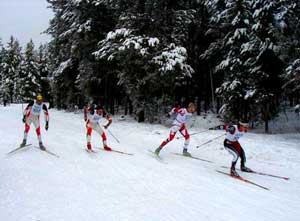 |
|
Sprinters |
Lesson with Torbjorn
Had a great session with Torbjorn Karlsen. He demonstrated and we practiced several variations of double pole technique. First there was what he called the "long double pole." This has nothing to do with the length of your poles, but with the length of your compression.
The long double-pole starts with the forward arm swing. As the arms swing forward and up, the poles swing slightly forward of vertical. This means that at the top of your pole swing, the tips are pointing slightly forward. I have always been taught that the pole swing stops short of vertical with pole tips pointing slightly to the rear.
Torbjorn says you get better extension and force if you let them swing slightly forward, then as you bring them down to plant them, the tip comes back to point slightly back. The long double pole ends with a slight bend of the knees, hands crossing your legs at mid calf or lower, and eyes looking at your feet. With your head in line with your body, this means a very deep compression.
The short double pole is done at a higher tempo, with shorter forward extension of poles, and the poling ends with the skier looking slightly in front of their skis, head in line with the body. So less compression and a shorter stroke than the long double pole technique.
Torbjorn told us that Justin Wadsworth, the Olympic skier he coaches, had been only using the short double pole technique in races. Torbjorn thought that this might be contributing to fading in the latter half of races. Now he uses the long double pole technique, especially in the early part of races to conserve energy. As a result, he has more energy at the end of the race to use the higher-tempo, short double-pole technique. Just one more weapon in the arsenal.
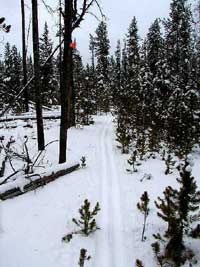 |
|
Park trail |
Torbjorn has obviously spent a great deal of time analyzing technique and is great at pointing out minor nuances.
As we were practicing the double pole techniques, skiing back and forth on a short section of trail, the US Ski team was doing lactate-testing right next to us as we turned around at one end. Trond Nystad, the US head coach was standing trailside with a notebook and a stopwatch. Team members were doing short laps on flat terrain with increasing intensity. Trond would ask their heart rate as they came to a stop.
The laps seemed to take about 5 to 10 minutes. A woman was taking blood samples from each team member as they completed each lap. The first time we saw them come around, they were skiing at a very easy pace. After three or four laps, the pace was very fast, with some visible strain and effort showing on the skiers' faces.
It would have been neat to see the results. Or better yet, jump in. Hey Trond, got enough capillary tubes for one more? Just want to see how my lactate's doin' today. Torbjorn has other ideas.
Racing Torbjorn
Torbjorn led us away for an easy classic ski. After skiing for about 15 minutes, Torbjorn stopped and said in his distinctive Norwegian accent, "Okay, we are going to have a short race."
He told us there was a trail intersection about 300 yards ahead, around a corner and down a hill. The intersection would be the finish line. We would race in pairs, one against the other. He paired us up, with both skiers in the track, one ahead of the other. Since there were only five of us, he paired himself with me. He started the first pair off with "Ready, set, go!" Thirty seconds later, he sent the second pair off.
Then it was our turn. He started behind me in the track, "giving me the advantage," he said. When he said go I started a little slowly, thinking that this might be a good strategy since I already had the lead. It was a good strategy for about 10 seconds. As we came to the first turn, Torbjorn stepped out of the track, accelerated, and cut across the turn, taking the lead. I started double-poling as fast as I could, but it was too little too late.
The whole section we were on was slightly downhill, so we were gaining speed as we went. After the turn the trail went more sharply downhill. Torbjorn stepped back into the tracks to take advantage of the faster glazed tracks. I was feeling a little tentative and unstable as our speed picked up and stayed out of the tracks.
I lost by quite a margin. Torbjorn looked back as he reached the finish and looked surprised by how far behind I was. When I reached him, he asked, "Did I out glide you?" He meant that perhaps he won because his skis were faster. I muttered something like yes that must be it.
Of course it is entirely possible that his skis were faster, considering he is an expert wax technician and wax distributor and I was still skiing on the wax from my last race the year before. But, it might also have something to do with the fact that Torbjorn is a National Masters race winner, a top 100 Birkie skier, and I am not.
Time for another race, Torbjorn says. This one starts with a downhill turn, then a short flat section then the finish line is 50 yards up the hill. This time, the winner from the first race will start with a handicap by starting farther back.
So Torbjorn starts about 50 feet behind me this time. I think he won the first one by more than 50 feet, but I couldn't bring myself to tell him to move farther back. Forget strategy this time, I tell myself. I want to preserve this 50 foot lead. I start double-poling like mad. Technique is the last thing on my mind. It is all about tempo. It was the fastest double poling I could do without sticking a pole into my foot, or worse, into my ski. I stepped out of the track to cut the corner. So far so good. I learned something from the first race. I double-pole furiously across the flat section then start my diagonal stride up the hill. Up to this point, Torbjorn was still behind me. I start thinking that maybe, just maybe I can pull this off.
Just then, out of the right corner of my eye, I see a blur. It is Torbjorn coming up on my right like Carl Lewis on skis. He is taking huge long diagonal strides and gaining a foot on me with every stride. There is no time to react. Another five seconds and the race is over.
After the race, Torbjorn said I had done everything right on the downhill and flat. "You did the right thing when you cut the corner," he said. "It was all I could do to keep up with you on the downhill and flat sections, but your turnover up the hill was not fast enough."
Even though I had lost, I felt good that I had stayed ahead of him for most of the race. I had a blast doing it. The short races were a great way to push technique to the limit without the suffering of a longer race. Now with what I've learned, I'm ready for a re-match. Just name the place, Tor, and I'll maybe even wax my skis this time.
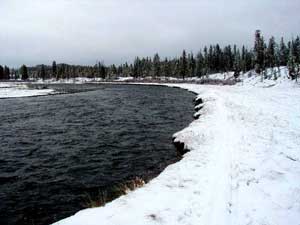 |
|
Gallantin River |
Jon Engen's mother
Jon Engen is another transplanted Norwegian, so common amongst the Nordic elite. He is a very astute and entertaining instructor. Jon took us back to the basics of classic technique.
If you can walk, you can ski, the saying goes. Most of us know better, but Jon takes us back to that simple analogy. "Most of you never needed instruction in how to walk," he says with a smile that makes us think he isn't really sure about some of us. "Just put one foot in front of the other and swing your arms. With skiing, we just add a little glide." Jon makes the transition from walking to his powerful balanced technique seem like child's play.
"My mother skis like this", he says, then demonstrates an upright, easy, slow, short-gliding technique. "Even skiing like this," he says, "she would pass people out here on these trails. When I ski with her, we pass people who are working too hard, using lots of energy, stopping to rest on a hill, catching their breath, slumped over their poles." He demonstrates a slumped over skier, breathing hard. "And my mother just slowly skis on by, then turns, and asks 'Are they okay? Do they need help?'"
His point was that we sometimes over-complicate technique and then also go out and work too hard in training.
Jon had each of us ski a short section using diagonal stride while he watched us. He then said he had a good mental image and could offer a bit of advice for each person. He told me that I needed to work on balance and to help with that, focus on getting my forward hand and pole grip over my opposite ski. This brings me well to the inside of my normal balance point. He said that Bill Koch brought his hand two inches outside of his ski. He said that as if to say if we thought bringing our hand inside to the point of our opposite ski was too far over, Bill Koch went even farther.
As the week progresses, my skiing has become stronger and more confident. My balance has improved significantly. Earlier in the week, with the adjustment to on-snow skiing and the altitude, the fun level was low and the effort level high.
Now, while the effort is still there on the hills, the fun level has gone way up. I feel very strong skating up the hills. The rolling terrain and long downhills are just a blast.
Skiing with Scott McGee, one of the instructors, I skied up next to him and said if more people realized how cool it is cruising on cross-country skis, the trails would be a lot more crowded.
While I feel stronger, at the same time, there is an underlying fatigue from the long hours of skiing. The fatigue makes itself felt at various times throughout the day. In the morning, I am very slow to get ready, even deliberately a few minutes late getting down to the class meeting place. I was disappointed this morning that I didn't miss anything. Everyone was just sitting on the floor waiting to be assigned to an instructor. It would have made me feel better if I had missed some calisthenics or something.
Not that they ever had us do calisthenics. One day when it was especially cold in the morning, we did do some indoor ski simulation exercises with Torbjorn leading us all in his version of Jane Fonda's workout.
At the end of a session, I would feel it in my arms as I double-pole or V2. I sometimes stop and think, "Ok that is enough, I'll just stop right here." But then I keep going, because I can't really stop in the middle of the trail, half a kilometer from the entrance.
Sunday
The camp is over. The place is emptying out. I had breakfast with Torbjorn, Mark, Laura, Jess, Judy, and a racer from Maine whose name I don't remember. Jess and Judy said goodbye after breakfast.
I went out to skate ski at 10:30. The fog from the last few days has left the trees looking like artificial frosted Christmas trees.
After three days of using demo skis, I am back to my Fischers, and what a difference. I had suspected that my skis were too soft. Too soft means the camber compresses too easily. It results in squirrelly behavior, sliding out, poor edging, and poor stability.
I experienced all of those symptoms today. The difference was dramatic. On demo Atomics the last two days, I skied aggressively and confidently. Today, I felt like I lost energy with every skate as my skis slid out to the side. Downhills were much tougher and scarier. It was demoralizing. Downhill turns required very careful edging and stepping. I plan to order new skis as soon as possible.
Into the Park
My last workout was an easy ski into Yellowstone Park. It was my first time skiing in Yellowstone National Park. The groomed trails for skiing in the camp are on the edge of town outside of the national park. The trail was partially groomed for classic, and then changed to skied-in only. My kick wax was mostly worn off, and I didn't feel like stopping to wax, so I double-poled the whole way. It was also a way to keep the intensity very easy.
The trail follows the Gallatin River through an area that looks to be recovering from either massive logging or a forest fire. The trail goes through, around, and sometimes straight over the top of small evergreen saplings.
It was an easy ski, mostly flat, except for one long uphill. It reminded me of the type of skiing I did when I first got into the sport--backcountry trail skiing through Pigeon River state forest. No groomed track. No corduroy. If we were lucky, we skied in someone else's tracks. Otherwise we made our own.
Back then it was not about going fast. It wasn't even about exercise. It was just a way to get out and explore the outdoors. It was hiking on skis. It was pure adventure to be out in the middle of winter in the middle of a forest, miles from any roads or motorized vehicles.
Being in Yellowstone brought back those feelings of adventure. I didn't know quite what to expect. I had heard stories--stories of buffalo and bald eagles. Jack Hart's wife had reportedly seen 40 buffalo when she skied on the same trail. Ernie Brumbaugh had reported seeing a dozen bald eagles. I had high hopes.
I stopped at the Free Heel and Wheel before I embarked for a café latte and a muffin. I asked Melissa how far I had to ski into the park before I started seeing neat stuff.
She looked at me like I was some kind of dumb tourist and said "You just have to go outside."
I said, "But I want to see some buffalo and bald eagles. Someone said they saw some in the park."
"You might want to see them but they don't want to see you," she said, "That's why they're called wild animals."
So I was properly humbled at the start. As it turned out, I saw only a pair of squirrels and a single black crow. It was a particularly entertaining pair of squirrels. They were chasing each other and jumping from tree to tree a good 50 feet off the ground. The trees were down at a lower level so I had a good view without having to look up. That was kind of neat, but tame compared to the advance billing of buffalo and all. Still made for a good easy final outing.
Ten days and 35 hours of skiing. It was probably a little too much skiing for training purposes. Overtraining does not always feel bad while you are doing it. But I had a great time. I would gladly do it all over again. I liked the Atomic skis so much I ordered a pair from Dick Fultz using a pay phone in the Atlanta airport while waiting for my flight. I highly recommend the West Yellowstone fall camp to anyone who likes to ski.
